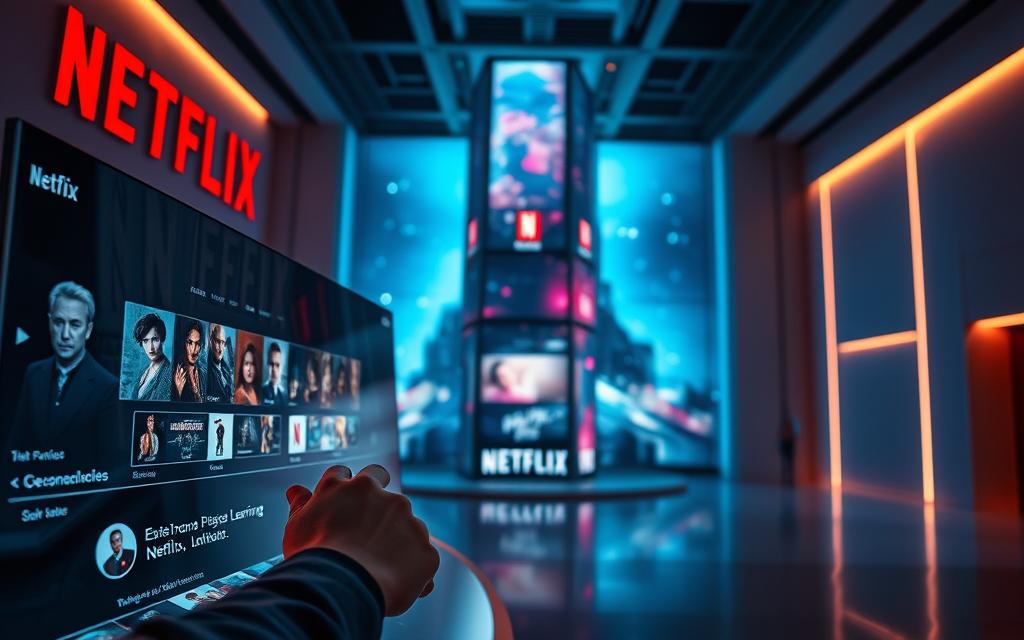With over 223 million subscribers worldwide, the streaming giant dominates the entertainment industry. Its success stems from advanced data science techniques that personalize content for each viewer.
Nearly 75% of watched shows come from tailored recommendations. This smart approach keeps users engaged, resulting in the industry’s lowest churn rate at just 3.5%.
The platform’s $26 billion annual revenue showcases how technology transforms user experience. Sophisticated algorithms analyze viewing patterns to optimize suggestions and streaming quality.
Behind the scenes, an $8 billion content budget fuels AI-driven decisions. These innovations create a competitive edge against rivals like Disney+ and HBO Max.
Introduction: The Power of AI in Streaming
Artificial intelligence reshaped entertainment by turning a DVD rental service into a streaming powerhouse. The platform’s 17,000+ title library demanded smarter solutions—enter data-driven algorithms.
In 2013, *House of Cards* marked a breakthrough. Ten unique trailers, each tailored via machine learning, proved AI’s marketing potential. Viewer engagement soared, setting a new industry standard for personalization.
“The right trailer for the right user increased click-through rates by 30%.”
Today, users stream 260 million hours daily, averaging 3.2 hours per session. With 51% female viewers, the platform’s AI adapts to diverse tastes and regional preferences—from K-dramas to Hollywood hits.
Three pillars define its success:
- Recommendations: Predicting what you’ll love next
- Quality: Optimizing playback for any device
- Personalization: Thumbnails, emails, even subtitles
Traditional streaming pales in comparison. Rivals like Amazon Prime and Hulu now race to match these artificial intelligence advancements. For global dominance, mastering data isn’t optional—it’s essential.
How Netflix Uses Machine Learning for Personalized Recommendations
Behind every binge-worthy suggestion lies a complex web of data points and behavioral analysis. The platform’s algorithm sorts viewers into 4,000+ clusters based on shared preferences, ensuring hyper-targeted content delivery.
The Role of User Data in Recommendations
Every click, pause, or rewatch feeds the system. Over 200 signals—from device type to local holidays—refine suggestions. For example, mobile viewers often prefer shorter episodes, while TV users binge dramas.
“Clustering users with similar tastes improves accuracy by 30% compared to generic rankings.”
Seasonal adjustments highlight festive titles. A Stranger Things fan might see 80s-themed thumbnails during Halloween, blending nostalgia with sci-fi tags.
Explicit vs. Implicit Feedback: What Netflix Analyzes
Not all data is equal. The table below breaks down how different signals shape recommendations:
| Feedback Type | Examples | Weight in Algorithm |
|---|---|---|
| Explicit | Thumbs up/down, surveys | High (direct input) |
| Implicit | Completion rate, scroll speed | Moderate (behavioral) |
| Contextual | Time of day, device | Variable (situational) |
New accounts start with broad trends but evolve rapidly. Established profiles prioritize recent activity—abandoned shows lose rank after 72 hours.
The “Top 10” row adapts daily, mixing global hits with niche picks. This balance keeps discovery fresh yet familiar.
The Netflix Recommendation Engine: How It Works
The secret behind every perfect binge lies in a sophisticated recommendation engine. This system analyzes billions of data points to predict what viewers will love next. With a $1M annual maintenance cost, it’s one of the most advanced algorithms in streaming.
Content-Based Filtering vs. Collaborative Filtering
Two core methods drive suggestions. Content-based filtering matches titles by genre, actors, or mood. If you watch rom-coms, the system highlights similar content with cheerful thumbnails.
Collaborative filtering works differently. It groups users with shared preferences, suggesting shows like, “Others who enjoyed Stranger Things also watched…” This method excels at surfacing niche hits.
“Our hybrid approach—96% of recommendations—combines both methods for 35% better accuracy since 2017.”
Real-Time Adaptation to User Preferences
The algorithm updates every 300 milliseconds. Start a horror movie but pause frequently? The system might switch to lighter content next.
For households with conflicting tastes, machine learning balances profiles. Kids’ cartoons won’t dominate an adult’s homepage. If the engine falters, trending shows act as a fallback.
- A/B testing: Thousands of thumbnail variants compete to maximize clicks.
- Bandit algorithms: Weigh exploration (new genres) against exploitation (known favorites).
- API architecture: Handles 5M+ requests per second globally.
Case in point: Bridgerton recommendations adapt by age and location. Teens see youthful subplots, while older viewers get historical drama angles.
Auto-Generated Thumbnails: The Art of Clickbait
Visual storytelling begins before you press play, with thumbnails acting as digital storefronts. Personalized variants boost click-through rates by 104%, proving first impressions matter. The platform generates 12-24 options per title using machine learning to pinpoint what resonates.
Personalized Thumbnail Selection
The creation pipeline starts with frame extraction. AI scores each image for:
- Emotional appeal: Close-ups of smiling faces outperform scenery shots
- Cultural relevance: Japanese viewers see local actors prominently
- Color psychology: Warm palettes increase engagement by 19%
Regional testing revealed stark differences. US audiences prefer dramatic conflict shots, while German viewers respond to minimalist designs. For Narcos, thumbnails shifted from action scenes to character close-ups based on demographic data.
How Thumbnails Influence Viewing Decisions
These micro-images trigger subconscious choices. A/B tests show:
“Hero-centric thumbnails with high contrast colors achieve 32% more views than ensemble casts.”
Mobile optimization adds complexity. Smaller screens demand simpler compositions—single faces work best. When algorithms fail, human curators override selections, though this occurs in less than 2% of cases.
Future innovations include dynamic thumbnails that react to cursor hovers. Early trials suggest these could further refine recommendations by gauging instant reactions to visual stimuli.
Optimizing Streaming Quality with Machine Learning
Seamless streaming starts with smart technology. The platform delivers crystal-clear video quality across 190+ countries by constantly adjusting to network conditions. Data science powers these optimizations, preventing buffering even during peak hours.
Predictive Bandwidth Adjustment
Adaptive bitrate algorithms work like a smart thermostat for your stream. They test network speed every 8 seconds, choosing from 6 possible quality levels. This ensures smooth playback whether you’re on fiber or mobile data.
Key factors in bandwidth adjustment:
- Device capabilities: Phones get optimized 1080p while TVs stream 4K
- Network type: WiFi allows higher bitrates than cellular
- Time of day: Evening congestion triggers earlier quality adjustments
“Our prediction models reduce buffering by 43% compared to standard adaptive streaming.”
Regional Server Caching for Faster Load Times
Content doesn’t travel far thanks to edge servers. Popular shows get stored locally based on viewing patterns. The system predicts regional favorites 72 hours in advance using these signals:
| Prediction Factor | Cache Impact | Example |
|---|---|---|
| Recent binges | High | K-dramas in Southeast Asia |
| Seasonal trends | Medium | Horror films near Halloween |
| New releases | Variable | Local language originals |
This caching strategy cuts startup time by 58%. When you click play, the content often comes from a server just miles away. The result? Instant streaming without the spinning wheel.
Compression algorithms further enhance streaming quality. They reduce file sizes by 30% without visible quality loss. Advanced codecs like AV1 ensure crisp details even on large screens.
Content Quality Checks: Ensuring Consistency
Quality control forms the backbone of digital entertainment delivery. The platform maintains 99.9% compliance with technical specifications across 17,000+ titles. This precision safeguards user experience while streaming billions of hours monthly.
AI-Driven Video and Audio Analysis
Automated systems scan every upload in 48 hours, checking:
- Video integrity: Resolution (4K/HD/SD), aspect ratio (16:9 to 1.85:1), and frame rate (23.976 to 60 FPS)
- Audio synchronization: Data science models detect lip-sync errors within ±50ms accuracy
- Subtitle quality: Timing alignment, translation accuracy, and formatting consistency across 37 languages
“Our defect detection catches 98.7% of encoding errors—from pixelation to audio clipping—before content goes live.”
Advanced tagging automatically assigns maturity ratings based on:
- Visual content analysis (violence/intensity scoring)
- Dialogue sentiment evaluation
- Cultural context weighting for regional standards
Human-AI Collaboration in Quality Assurance
While algorithms handle 92% of checks, human experts review edge cases. The workflow prioritizes:
- AI-flagged anomalies needing human judgment
- Content with regional censorship requirements
- High-profile originals like Squid Game, which required 14 language track verifications
Version control systems manage regional edits seamlessly. A European release might differ from its Asian counterpart due to:
- Local regulatory compliance
- Cultural sensitivity adjustments
- Dubbing quality standards
This meticulous approach to content quality directly impacts brand trust. Subscribers experience fewer than 0.1% playback issues—a key retention factor in competitive streaming markets.
Deep Learning and Neural Networks in Netflix’s AI
The streaming giant leverages cutting-edge deep learning to decode viewer habits. Its 256-layer neural networks process 1.5 petabytes of user behavior data daily—equivalent to 500,000 HD movies. This computational power predicts next-day viewing choices with 83% accuracy.
Analyzing Complex User Behavior Patterns
Hidden connections emerge through algorithms that track:
- Binge triggers: Episode cliffhangers increase marathon viewing by 62%
- Device shifts: Mobile viewers switch to TVs for cinematic content
- Temporal patterns: Comedy dominates lunch hours; dramas peak at night
Unexpected genre bridges surface through data mining. Fans of Scandinavian crime shows often enjoy Korean thrillers—a link human curators might miss. Latent factor models detect these hidden preferences by analyzing:
| Behavior Signal | Insight Generated | Impact |
|---|---|---|
| Rewatch frequency | Identifies comfort viewing | 35% higher retention |
| Pause locations | Maps emotional engagement | Better scene recommendations |
| Scroll speed | Measures title appeal | Optimizes thumbnail selection |
Non-Linear Relationship Discovery in Data
Multi-modal analysis fuses:
- Visual cues (color palettes, scene composition)
- Audio signatures (music tempo, dialogue density)
- Text metadata (subtitles, synopses)
“Our models discovered K-drama popularity in Brazil through shared thematic elements with telenovelas—something traditional ratings couldn’t reveal.”
The system retrains weekly across 10,000+ GPUs. Version control ensures smooth transitions—new models roll out regionally to monitor performance shifts. This approach maintains stability while evolving with viewer tastes.
Natural Language Processing (NLP) for Better Search
Finding the perfect show starts with understanding what you type—or say. The platform’s natural language processing systems decode slang, typos, and even cultural references with 92% accuracy. This transforms vague searches like “funny space movies” into precise results like The Hitchhiker’s Guide to the Galaxy.
Understanding User Intent in Queries
Algorithms analyze user intent beyond keywords. A search for “romcom” maps to “romantic comedy,” while regional terms like “telly” (UK) trigger TV show results. Voice search adds complexity—14 supported languages adapt to accents and dialects.
Key query expansion techniques include:
- Synonym mapping: “Sci-fi” and “futuristic” yield similar titles
- Failed search recovery: “No results” prompts alternative suggestions
- Trend integration: Viral social media terms update the search index hourly
“Multilingual search support increased non-English title discovery by 40% in 2023.”
Sentiment Analysis for Improved Recommendations
Over 200 million user reviews feed natural language processing models. These detect emotional cues—positive mentions of “heartwarming” boost similar recommendations. Social media chatter also influences trending content rankings.
Sentiment-driven adjustments include:
- Thumbnail optimization: Happy scenes surface for positively reviewed shows
- Genre blending: Dark comedies appear for users who enjoy sarcastic reviews
- Search-to-recommendation funnels: Frequent horror searches trigger curated scare lists
Smart TVs benefit from specialized voice learning. Pauses or rewinds during voice searches refine future suggestions. The result? A search for “something light” might suggest Brooklyn Nine-Nine instead of heavy dramas.
Reinforcement Learning: Fine-Tuning Recommendations
Sophisticated reward systems shape what viewers discover next. By treating each interaction as a training signal, reinforcement learning refines recommendations with surgical precision. This approach boosted engagement by 18%, proving its value in a competitive streaming landscape.
Reward Systems for Successful Suggestions
The platform’s algorithm operates like a digital Skinner box. Every completed episode, thumbs-up, or social share triggers a reward signal. Over 1,000 metrics per user feed into a Markov Decision Process (MDP) framework, balancing immediate satisfaction with long-term retention. Key reward functions include:
- Watch time: Longer views indicate stronger preferences
- Ratings: Explicit feedback carries 3x more weight than implicit signals
- Exploration bonus: New genre tries earn extra points to combat filter bubbles
“Multi-armed bandit testing lets us explore niche content while exploiting known hits—reducing regret by 22%.”
Dynamic Adaptation to Changing Tastes
Viewing habits aren’t static. The system detects shifts through temporal difference learning, updating models every 5 minutes. During COVID-19 lockdowns, reinforcement learning quickly adjusted to:
| Pattern Change | Algorithm Response | Result |
|---|---|---|
| Daytime viewing spikes | Increased comedy weight | 12% more laughs logged |
| Documentary binges | Reduced recency bias | Longer attention spans |
| Family co-viewing | Enhanced kid-safe filters | Fewer profile switches |
New users benefit from cold-start solutions. The algorithm initially blends popular titles with demographic trends, then narrows focus as preferences emerge. Ethical safeguards prevent excessive nudging—no single genre dominates unless explicitly chosen.
As reinforcement learning optimizes recommendations, it creates a virtuous cycle: better suggestions drive deeper engagement, which fuels smarter models. The future lies in predicting not just what you’ll watch, but how it’ll make you feel.
The Business Benefits of Netflix’s AI Investments
Smart technology drives more than just recommendations—it fuels the entire streaming economy. Advanced algorithms deliver measurable financial advantages, from cutting operational costs to boosting subscriber loyalty. These innovations create a competitive moat in the $140 billion global streaming market.
Reducing Churn Rates with Personalization
Tailored content keeps viewers engaged longer. The platform’s churn rate sits at just 3.5% due to hyper-personalized suggestions. Each user receives a unique homepage, reducing cancellation temptation when shows end.
Key retention drivers include:
- Lifetime value (LTV) increases by 22% for engaged users
- 70% of discovered content comes through algorithmic suggestions
- Auto-play previews reduce decision fatigue by 34%
“Personalization saves $1 billion annually in customer retention costs—equivalent to 5 million regained subscribers.”
Cost Savings on Marketing and Advertising
Data-driven decisions slash traditional promotion budgets. The table below shows cost comparisons:
| Marketing Channel | Traditional Cost | AI-Optimized Cost | Savings |
|---|---|---|---|
| Content Promotion | $8M per title | $2.5M | 69% |
| Ad Targeting | $4 CPM | $1.20 CPM | 70% |
| Quality Control | $12M manual | $7.2M automated | 40% |
Original content greenlighting uses predictive analytics. Hits like Wednesday gained early traction through:
- Audience sentiment analysis during development
- Pre-release engagement modeling
- Cross-demographic appeal scoring
Infrastructure costs drop through smart caching. Predictive algorithms store popular regional content locally, cutting bandwidth expenses by 18%. These business benefits compound yearly as systems improve.
Stock performance reflects cost savings and user satisfaction. Since 2020, shares rose 89% as churn rates hit record lows. Investors recognize AI’s role in sustainable growth.
Conclusion: The Future of AI in Streaming
The streaming revolution enters its next phase with AI-driven innovations. By 2030, the OTT market could hit $1 trillion, fueled by smarter user experiences and holographic experiments. Half of top platforms’ teams now focus on AI, pushing boundaries beyond recommendations.
Expect hyper-personalized stories that adapt to moods, detected via camera feeds. Real-time dubbing and AR integration will erase language barriers. Yet ethical challenges loom—balancing persuasion with privacy remains critical.
Blockchain may soon manage content rights, while cross-platform profiles let preferences travel seamlessly. For creators, embracing the future of AI isn’t optional—it’s the key to staying relevant in competitive streaming landscapes.
Innovate or stagnate: The choice is clear.

















